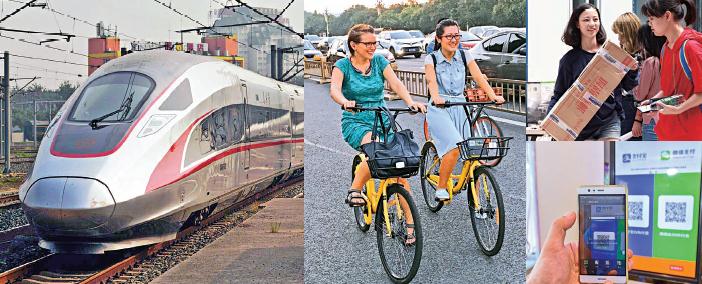Japanese Media: China amazes with new Four Great Inventions

China’s “new four great inventions”—the G-series high-speed train, bike-sharing, mobile payment and online shopping—have brought about convenience for people’s lives.
“The ‘Belt and Road’ initiative is changing the world. If we fail to swim with the tide of history, we will be left behind.” This is the core idea of the Belt and Road portion in Japan’s NHK TV documentary China the Great Dragon. Before the opening of the 19th CPC National Congress, multiple media agencies in Japan reported on the achievements China has made in the last five years.
The documentary shows the vast farmlands of Kazakhstan, the classic small commodities markets in Poland and an advanced robotics production center in Germany. They are now linked within a huge economic circle by the “B&R” initiative. The cameras captured images of tall buildings and large mansions in the Kazakh capital Astana that were constructed with building materials produced in China-funded brickyards. They also captured scenes of merchants from Eastern European countries who drove thousands of miles to buy goods at the China Mall in Warsaw, Poland. Annually, more than 1,000 trains from China arrive at Durisburg, Germany. In 2016, China became Germany’s biggest trade partner, and bilateral economic and trade relations are only expected to grow from there.
The documentary featured the Eurasian continental railway, which relies on China’s investment and operation. Shipping between China and European countries on the railway takes one-third the time of sea transportation, and goods can be delivered at only one-fifth the cost of air transportation.
It also shows many ordinary Chinese farmers cultivating farmland in Central Asia as well as Chinese merchants involved in the Eastern European markets and those who find opportunities in the mass e-commence world. By getting involved in “B&R” construction, they enriched themselves and realized their dreams.
“The four great inventions in ancient China—gun powder, compass, paper-making techniques and printing—were spread to the world via the Silk Road. Now the ‘new four great inventions’ consisting of G-series high-speed train, bike-sharing, mobile payment and online shopping have become the most popular products that international students along the ‘Belt and Road’ countries want to take back home,” according to a news report on the Nihon Keizai Shimbun on Oct. 16.
The report showed the ways the four inventions have made the world more convenient with a series of statistics. China has the most operational high-speed railway track in the world, and the top speed for its trains has been raised to 350 kilometers per hour. Many tourists at home love to travel by high-speed railway. In big cities, such as Beijing and Shanghai, bike-sharing has gone viral, and there are now more than 100 million users. Along the West Lake in Hangzhou, Zhejiang Province, bike-sharing companies placed 100,000 bikes so that tourists can visit places of interest on bikes. Also, in order to attract Chinese tourists, more overseas shops are providing mobile payment services. In terms of online shopping, various enterprises are carrying out festival promotions. The four new great inventions have enhanced the convenience of travel and promoted consumption.
In addition, a previous report, titled “Japan Should Face the Fact that China is a Power of Innovation,” noted that private enterprises in China have developed quickly. In the last five years, the Chinese government has encouraged innovation and entrepreneurship by increasing funding support and building infrastructure, aiming to raise the employment rate. In 2016, more than 600,000 Chinese college students started their own businesses. According to Japanese media, it is waiting to be seen whether the new Four Great Inventions will go viral around the globe.
LIU YANG is a reporter at the Chinese Social Sciences Today.
